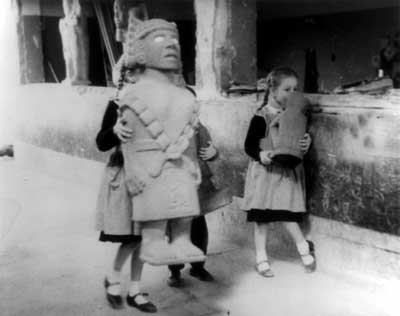Now
Screening:
“Ruins” by Jesse Lerner
( B&W 16mm, 78 min., 1999,
with
Sylvanus Morley, Brigido Lara, Maria Elena Gaitan and Lord Edward Kingborough)
Dec
7, 2002 at 8:00pm

Billed up front as "a fake documentary"--hmmm, couldn't we have had just a moment of suspended disbelief?--L.A.-based Jesse Lerner's ingenious feature is a poker-faced critique of Eurocentrism, its oft-condescending "interpretations" of "primitve" cultures, and how they eventually become packaged as tourist kitsch. Focusing on the alleged restoration of artefacts and Monuments from Mexico's precolonial eras, Lerner throws together "archival" footage dating back almost a hundred years. Some of it is real, some ersatz. You'll be hard pressed to tell the difference, since the distressed B&W images look equally "aged," and the imperialist biases of various archaeologists, curators, et. al. appear equally brazen, throughout. Ruins is a fascinating intellectual joke that isn't laughing when it asks, "Who decides our history for us? Whose standards 'evaluate' culture?" Needless to say, the documentary filmmaking form itself does not escape Lerner's subversive satire unscathed.
--Dennis Harvey, San Francisco Bay Guardian
Counterfeiting is a practice with broad and devious implications, from the merest of fake objects to entire histories shaped as facsimile. Jesse Lerner's provocative Ruins takes the forger's art and applies it to the appropriation of culture, in this case, Mexican. The prologue to this wizardly jumble of newsreel snippets, travelogia, and stagy rants collates early colonial misconceptions of Mexico's populace, a stewpot of ethnographic and political distortions. From there, Lerner charts the rarefaction of this process that recontextualizes archeological objects as art. In this cultural valuation, Mayan and Aztec objects are severed from their origins and further rarefied within the confines of museums. At the center of Ruins is Brigido Lara, a master forger whose "Pre-Columbian" objects have been displayed in major (and unwitting) museums throughout the U.S. and Europe. Is this the final subterfuge of the colonial project----the real and the fake, indistinguishable? Ruins builds a diverting argument from the (imitation) detritus of culture.
--Steve Seid, Pacific Film Archives
The complexities of historical authenticities are explored in Jesse Lerner's provocative experimental film. Ruins constructs a hilariously inventive, hybrid documentary form by sampling aspects of the newsreel, the travelogue, the enthnography, the polemic, and the home movie. The film focuses on the histories of the Mayan and pre-Colombian artifacts and follows their trajectory from their discovery at an archeological excavation, through a subjective interpretation process (usually Eurocentric), where meaning and intent change, to a final resting place in a prestigious American museum. Lerner draws clear parallels between the fake (art reproductions) and this "fake" documentary film by interrogating notions of expertise and authority as they relate to authenticity--not simply in the world of Mexican art but in that of documentary as well. Using personal testimonies and omnipotent narrators, he plays with style while never allowing his visual sensibilities to overstate the biting central questions of the film. At Ruins end, Lerner purposefully and effectively undermines the label "authentic" when he recounts the exploits of Brigado Lara, a talented forger of pre-Columbian art, who fooled everyone--including New York's Metropolitan Museum--by replicating an artifact so well even experts claimed its authenticity. Lerner melds deteriorating archival clips with distressed original interviews, creating the impression that the celluloid is itself a ruin. Ruins celebrates irreverence through the collision of image after image at a frenetic pace, and in the process, delights its viewers with its astute commentary and aesthetic mastery.
--Beth Irizarry, Sundance Film Festival
Much like Umberto Eco did with his book Travels in Hyperreality, Lerner uses his film Ruins to question whether or not what "experts" present to the public as reality might actually be fake. In this pseudo-documentary, newsreels travelogues, and home movies are combined to trace the path of several ancient Mayan artifacts from the time they are removed from their native soils to their arrival in a new home, a museum in the United States. Along the way, academics, all of European descent, decide what the history of these objects was, thus ascribing to them a new reality. However, the true genius of Lerner's work comes not from his attacks on the learned, but in the questioning of his own enterprise. He pokes fun at the fact that filmmakers are no different from people in academia, since neither have yet to corner the market on truth and must continue to tell stories based on what their imperfect eyes see. All this, and a fast-paced, but not overpowering, visual style, make this often funny film a "true original."
-Athens International Film and Video Festival
Los Angeles-based media artist Jesse Lerner returns to Filmforum this week
with Ruins, his latest project, which he calls a "fake documentary." Lerner is known not only for his earlier films and videos, including the insightful exploration of U.S./Mexican cultural hybridity in Frontierland (1995, with Ruben Ortiz Torres), but also "Mexperimental," the important first exhibition and catalog of Mexican experimental media (curated with Rita Gonzalez). Lerner continues his examination of Mexico in Ruins, which charts not only the reading of actual ruins in Mexico, an act that for visitors is always invested with a particular agenda, but also the contemporary fabrication of artifacts and a questioning of the hierarchies of the fake and the real. Mixing a wonderfully confusing array of footage and animated sequences, Lerner upsets easy assumptions about history--here certain images look old and it's easy to assume you're watching archival footage. But then the voice-over text is preposterous, and it becomes clear that the footage is fake. Similarly, historical texts are so outrageously racist that it's difficult to believe that they are in fact real. The overall result--and this is Lerner's particular brilliance as an artist--is the creation of a fantastic, spiraling vertigo of fact and fiction that unsettles the very notion of historical documents, and of documentary filmmaking itself.
--Holly Willis, Los Angeles WeeklyRuins
Jesse Lerner
P.O. Box 24"B"53
Los Angeles, CA 90024-1153
tel./fax: (213) 621-2719
